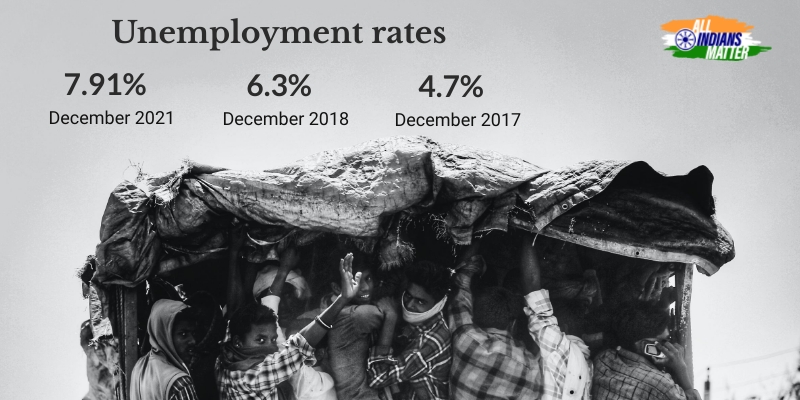Ashraf Engineer
January 22, 2022
EPISODE TRANSCRIPT
Hello and welcome to All Indians Matter. I am Ashraf Engineer.
India simply can’t seem to make a dent in soaring unemployment numbers. According to the Centre for Monitoring Indian Economy, unemployment hit 7.91% in December 2021 compared to 6.3% at the same time in 2018-19 and 4.7% in 2017-18. In fact, unemployment numbers began rising at that stage, four years ago – which shows that COVID-19 isn’t the only factor. As livelihood distress becomes ubiquitous, All Indians Matter kicks off a special two-part series called ‘Where are the jobs?’. In the first part, we look at the data, the causes of widespread unemployment and what the long-term outlook is.
SIGNATURE TUNE
The government is highlighting GDP growth; what it isn’t telling you is that it is being calculated on a much lower base because COVID-19 wiped out much of the economy in 2020. So, even a little growth comes across as much larger when expressed in percentage terms. And here’s what the government isn’t talking about at all: unemployment.
In urban areas, unemployment rose to 9.3% in December last year from 8.09% in January. In rural areas, it stands at 7.28% against 5.81% in January 2021. The numbers are higher in cities because between 2019-20 and December 2021, 9.8 million manufacturing jobs were lost. As a result, millions moved back to their villages to either no employment or lower earnings.
It’s not just the number of jobs, but also their quality. The percentage of salaried people dropped from 21.2% in 2019-20 to 19%. Translation: 9.5 million have left paying jobs to either become jobless or part of the informal sector. And it’s not as if the informal sector has been left unscathed. In fact, it’s among the worst affected.
But let’s look at the overall numbers — the number of employed people between 2019-20 and December 2021 has shrunk from 408.9 million to 406 million. This, at a time when 10 million young Indians are entering the job market every year.
Critically, the age group of 20 to 29 saw monthly employment numbers plummet by 15.6% between January 2019 and July 2021. This is a continuation of what the National Sample Survey Office found in 2019. At that time, India had the highest unemployment rate in 45 years, particularly among the youth – 34% of those between 20 and 24 years were unemployed.
What are the numbers now? CMIE says that, for the 20 to 29 year age group, unemployment is roughly 28%. That translates to 30.8 million young people, compared to 17.8 million in 2017.
It’s a matter of even greater concern that the more educated you are, the greater the likelihood of you being unemployed — 63.4% of graduates between 20 and 24 years of age were unemployed.
The news isn’t good if you slice the numbers by gender either. Unemployment among women is higher than men across all areas – 14.28% compared to 7.88% for men.
It’s catch-22. India isn’t likely to generate jobs in a hurry unless private investment picks up. However, that investment rate has been declining — from 34.3% in 2011 to 27% in 2020. Weak demand is one of the main reasons, but it is caused at least in part by rising joblessness. If demand is weak, then businesses refrain from hiring. But, unless more people are hired, demand won’t rise. This makes for a vicious circle that hurts middle- and low-income families the most.
All this raises serious concerns about the economic recovery. What exactly is its nature and who is benefiting from it? Who are the people left behind?
As I said earlier, the data shows that the fall in employment began well before the pandemic. And the political and social turmoil isn’t helping. Let’s not forget either the poor decision-making of the past, the price for which we are paying even today. I’m referring to the sudden demonetisation that led to numerous deaths and financially destroyed so many lives. The botched rollout of the Goods and Services Tax combined with it to set back corporate investment and, in turn, jobs.
With the COVID-19 pandemic still with us, the road to recovery seems even more uphill. The job losses, many feel, could be long-term and it’ll take a lot more than chest-thumping to get India working again.
Next week, we will look at unemployment and job losses in the states set to hold Assembly elections a few weeks from now.
Thank you all for listening. Please visit allindiansmatter.in for more columns and audio podcasts. You can follow me on Twitter at @AshrafEngineer and @AllIndiansCount. Search for the All Indians Matter page on Facebook. On Instagram, the handle is @AllIndiansMatter. Email me at editor@www.allindiansmatter.in. Catch you again soon.






